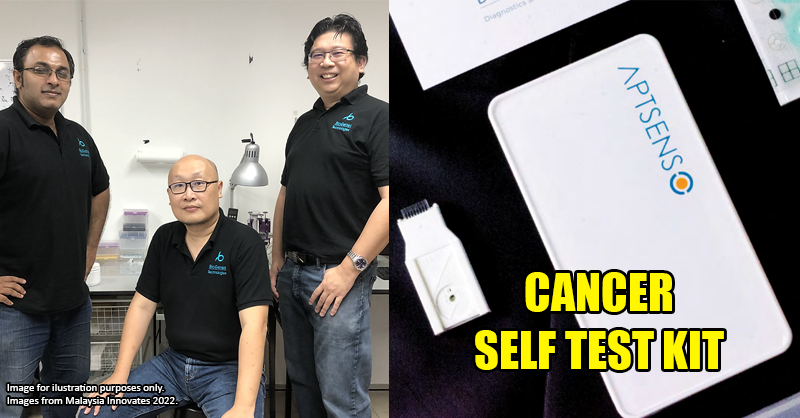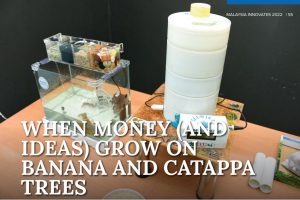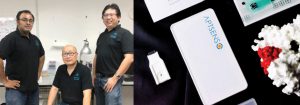4 simple but brilliant Malaysian inventions that solved everyday problems.

- 195Shares
- Facebook170
- Twitter6
- LinkedIn6
- Email7
- WhatsApp6
Hey hey, people. Y’all ever remember reading the Doraemon comics when you were a kid and wishing that his magical gadgets were real? Yeah, us too.

Well, the dream might not be that far off. While they’re not quite at the level of the 22nd century yet, some of the inventions we saw at the Malaysia Innovates Summit 2022 – basically a conference for Malaysian inventors – were pretty extraordinary. Take this, for instance…
1. A wastewater filter that uses plant parts

This is something that not many Malaysians have heard of, but many cities around the world have a “fatberg” problem in their sewers. It’s essentially a giant mass of coagulated fat, grease, sanitary wipes and other gunk that can clog up underground pipes. Yeah, so don’t dump trash down the toilet and pour used cooking oil down your kitchen sinks.
Concerned with the big nasty clogging up the pipes, Noor Liza turned to tradition for a solution – she saw how kampung people soaked their greasy kitchenware in water together with banana leaves, and supposedly, the leaves would absorb grease and oil, making cleaning easier.

That sparked something in her noggin, after four years of ups and downs, she finally came up with a prototype of “My Filtro Aqua Natsponge“. Fibers from the banana tree stem were used to fashion a sponge that would be part of the first layer of the filter, and later on, she added Catappa leaves – which are used in aquariums due to their pH-lowering and antibacterial properties – to the mix.
The Natsponge’s final form not only filters out grease from wastewater, it also prevents clogs and bacteria from building up in your own kitchen pipes.
2. Many mosquitos, one cup

The mosquito is the single deadliest animal in the world (yeah, it’s not sharks) cuz these lil’ buggers are vehicles for diseases like malaria and dengue. Lim Chee Hwa, Managing Director of One Team Networks Sdn. Bhd. was ostensibly not a fan of mosquitos, and he teamed up with an entomologist (a scientist who studies insects) to create AedesTech.
At its core, AedesTech is a cup-looking thing that lures Aedes mosquitos to lay their eggs inside, and the chemical within stops the hatched baby mosquitos from becoming adults which in turn stops them from spreading dengue. And since mosquitos rarely lay their eggs in one place, the chemical gets carried to other egg-laying spots, effectively making the AedesTech some sort of Aedes Thanos.
3. A device that lets you test for cancer and other diseases at home

Continuing the streak of Marvel references, the Biogenes APTSENS is a Tony Stark-esque, USB-looking device that lets you test for different kinds of diseases, like various forms of cancer, viral and bacterial infections, and even dengue. On top of that, it can be used to monitor your blood sugar levels, making it fantastic for diabetics who don’t wanna drive an hour to the nearest hospital to check whether they’ve got too much glucose in their veins.
That last part wasn’t a joke – Adrian Joseph, one of the co-founders of Biogenes Technologies Sdn. Bhd. (the company behind Biogenes APTSENS) cited the hassle that patients have to go through just to get a “five-minute blood and urine sampling” as their inspiration for the creation of the APTSENS.
“We wanted to help our elderly parents who live miles away from us. That is why we believe we can provide better and faster ways to do all these, so that our elderly could live hassle-free and risk-free, and we could monitor and record their health conditions remotely.” – Adrian Joseph, as quoted from Malaysia Innovates 2022.
Oh, that’s right, the APTSENS works in tandem with a smartphone app, so users will have a record of test results should they wish to look them up whenever.
4. Giving mushrooms superpowers using gamma radiation

Yep, you’ve read that right: we’re using radioactivity to come up with special mushrooms. You know how wild bananas are different that commercial bananas? Wild bananas typically have a lot of seeds, but over time banana farmers picked the ones with less seeds and crossed them together, eventually coming up with seedless bananas that we have today.
The concept with irradiating crops is pretty much the same, but instead of waiting for the perfect parents to come along and pass on their good genes, we expose them to gamma rays so that their genes get altered. It’s like hitting the re-roll button on the crops’ stats. The Malaysian Nuclear Agency had been doing that with various plants, and recently they’ve managed to give some shiitake mushrooms superpowers.
Previously, these mushrooms can only be planted in the highlands, but after bombarding some of them with gamma rays, some developed a resistance that allows them to be planted in the lowlands as well. These mushrooms, like other irradiated plants, aren’t classified as Genetically Modified Organisms (GMOs) as we didn’t insert additional DNA into the mushroom’s cells. But perhaps more importantly, the mushrooms don’t become radioactive themselves, so they’re still safe.
You can check out the Malaysia Innovates 2022 report for more cool inventions. No cap.
All of the inventions we covered above were taken from the Malaysia Innovates 2022 report, and even though there are so many more interesting ones, we didn’t want this article to be 20 pages long. So if y’all are interested in checking out other local inventions, like a new anti-inflammatory cream for eczema or a high-tech way for farmers to calculate how much seeds they need, feel free to check out the report.
- 195Shares
- Facebook170
- Twitter6
- LinkedIn6
- Email7
- WhatsApp6
